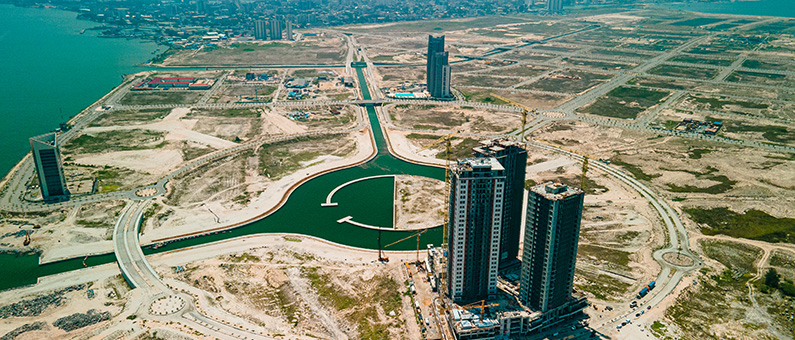Obiamaka Nnadika
On Victoria Island, which is next to Lagos, Nigeria, a brand-new coastal city called Eko Atlantic is being constructed. It serves as a hub for investors looking to profit from the rich development boom caused by high demand as well as a point of entry into the continent’s rising markets.The Eko Atlantic City was inaugurated in 2016 by Akinwumi Ambode, the governor of Lagos State at the time.
The modern city is expected to be the size of Manhattan’s skyscraper district, standing on 10 million square meters of land that has been reclaimed from the ocean and shielded by an 8.5-kilometer sea wall. It has cutting-edge urban planning, its own power generation, clean water, cutting-edge telecommunications, open roadways, and tree-lined streets. It is self-sufficient and sustainable.

The project’s developers and city planners, South Energyx Nigeria Limited, provided private funding for it. Although the coastal city is portrayed as a new and exciting initiative that will bolster the economic trajectory of the Lagos Island region, there seems to be a lot of contention surrounding the environmental effects that the construction is causing the local area
The location of Eko Atlantic City is situated on land reclaimed from erosion near the coast of Lagos. In order to protect the reclaimed land from flooding due to ocean surges, a coastal revetment known locally as the Great Wall of Lagos was constructed in 2009
The Great wall is constructed primarily of rock and faced with concrete accropode armor. Since its initial installation, the wall has successfully kept major floods from affecting the ongoing construction of Eko Atlantic.

However, nearby locals blame the dredging construction process for the increased frequency of sea surges and soil erosion within the area. They claim that the sand stock is insufficient for construction and the dredging increases the energy of waves while the sea walls divert its impact towards the east.
In trying to explain how the great wall in Eko Atlantic will worsen the situation for neighboring areas, Dr. Alan Blumberg mentioned that because of the storm an approaching surge will come up to the wall, and it will move left or right of the wall, searching for weakness or a low spot.
Lagos’ susceptibility to rising sea levels only seems to have drastic effects for poorer communities than wealthier parts. Just a few miles from the glitzy Eko Atlantic construction are low income communities like Magodo that are continually ravaged by the disastrous environmental effects of rising sea levels.
The government has no future plans of helping low-income communities divert the effects of sea surges away from their homes and businesses. Citizens are left to essentially fend for themselves as the ocean ravages their sources of livelihood, leaving many both homeless and jobless.

The stark contrast between Eko Atlantic and the reality of what many Nigerians face is very polarizing. One one hand, Eko Atlantic is seen to be this beacon of economic prosperity to Lagos. The businesses and jobs the construction promises to provide will aid in boosting the overall economy of the state. However, the resources that are pumped daily to ensure the economic success of Lagos comes at a major disadvantage to their surrounding neighbors.
References:
https://qz.com/africa/923142/the-flaw-in-the-construction-of-eko-atlantic-island-in-lagos
https://www.ekoatlantic.com/wp-content/uploads/2012/12/EkoAtlantic-EIA-Summary.pdf
https://www.ejatlas.org/print/eko-atlantic-city-lagos-nigeria
